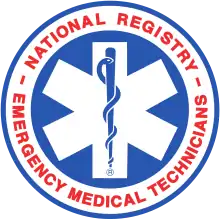National Registry of Emergency Medical Technicians
The National Registry of Emergency Medical Technicians is a US certification agency covering prehospital medical providers.

History
NREMT was established in 1970 in response to a recommendation from President Lyndon Johnson's Committee on Highway Traffic Safety that a national certifying agency for Emergency Medical Technicians be created in order to establish and standardize training requirements.[1]
Standards
Most states use or require NREMT testing for some level of state certification.[1][2][3] NREMT recognizes four levels of EMS: EMR, EMT, EMT-Advanced, and Paramedic (some states may have additional certifications).[2] NREMT certification at an EMT Intermediate level may or may not be sufficient for some state EMT-I requirements.[4] While NREMT certification may be mandatory for new state certification, it is not necessarily required for renewals.[4] These procedures and requirements vary from state to state. In 1986, military emergency rooms were required to certify all medical technicians through NREMT.[5]
Levels of certification
Nationally Registered Paramedic (NRP)
Highest level of certification through the NREMT. This represents the highest level of national certification. Paramedics are considered Advanced Life Support (ALS) and can administer a range of medication, as well as perform advanced electrical and invasive surgical interventions (please see Paramedics for a full list of skills.) In the United States, NRP Paramedics typically consist of a one year program or two year associates degree program consisting of over 1800 hours of didactic and clinical education focusing on acute emergency stabilization and prehospital care.
Nationally Registered Advanced Emergency Medical Technician (NRAEMT)
1999 EMT-Intermediate National Standard Curriculum as defined by the Department of Transportation - National Highway Traffic Safety Administration (NHTSA)[6] This level can also provide certain drug therapies.
Nationally Registered Emergency Medical Technician (NREMT)
This level of certification provides Basic Life Support (BLS). (please see Emergency medical technician for a full list of skills)
Nationally Registered Emergency Medical Responder (NREMR)
This is the entry level into emergency medical services (EMS). They are trained in CPR, advanced first aid, automated external defibrillator usage, and patient assessment. Most police and fire services require their employees to be emergency medical responders at a minimum. This course is usually 40–60 hours in length.[7]
EMS-ID
The NREMT launched the EMS-ID system on January 23rd 2020, modeled after the National Provider Identifier (NPI). The idea being that one identifier could be issued to a verified individual upon creation of an NREMT account, which could then reference all certifications for said individual. The number would remain constant, even if the individual changed their name, national certification level, ect.[8] Similar to the NPI number issued by the Centers for Medicare and Medicaid Services (CMS), the number is a 12-position, intelligence-free numeric identifier (12-digit number). The EMS-ID is not intended to replace the individual registry number.[9]
Controversy
The NREMT has been criticized for failing to prevent cheating during some exams. The Washington, D.C. Fire Department[10] was investigated for cheating on the NREMT certification exam;[11] however, an extensive investigation[12] by the NREMT, Pearson VUE (the test administrator), with assistance from the DC Fire and EMS department[13] and the DC police, revealed no evidence of cheating at Pearson VUE’s LaPlata, MD testing center.
The NREMT works with the EMS community to implement the National EMS System including the EMS Agenda for the Future,[14] EMS Education Agenda: A Systems Approach,[15] and National Scope of Practice Model.[16]
See also
- National Association of Emergency Medical Technicians (NAEMT)
- Medic
- Combat medic
- Star of Life
- Ambulance
- Emergency medical services
- Emergency medical services in the United States
- Emergency medical technician
- National Registry Emergency Medical Technician
- Emergency medical technician – intermediate
- EMT-Paramedic
References
- NREMT History
- Emergency Medical Technician from US Bureau of Labor Statistics
- "Emergency Medical Technicians" from University of Missouri, St. Louis
- Colorado EMT requirement overview
- "National Registry of EMT Certification of Air Force Emergency Room Technicians" from the Defense Technical Information Center
- DOT Standards for EMT-I
- Ventura, Christian. The Emergency Medical Responder: Training and Succeeding as an EMT/EMR. Springer International Publishing. ISBN 978-3-030-64395-9.
- "National Registry of EMTs". National Registry of EMTs. Retrieved 2020-09-27.
- "EMS ID - Q&A with Donnie Woodyard" (PDF). Retrieved 27 September 2020.
- "District of Columbia Fire Department - "The Real Deal"". DCFD.com. Retrieved 2010-12-01.
- "City Investigates Alleged Cheating on EMT Test". washingtonpost.com. 2009-04-24. Retrieved 2010-12-01.
- "Investigative Outcome of a Reported Compromise on the National EMS Certification Examination - News - at". Jems.com. Retrieved 2010-12-01.
- "FEMS". Fems.dc.gov. Archived from the original on 2010-11-17. Retrieved 2010-12-01.
- "EMS Agenda for the Future Implementation Guide". Nhtsa.gov. Retrieved 2010-12-01.
- "EMS Education Agenda for the Future: A Systems Approach". Nhtsa.gov. Retrieved 2010-12-01.
- Nasemsd.org